Research on Coping Strategies and Anxiety in Nurses during COVID-19
VerifiedAdded on 2023/06/15
|60
|22362
|301
Report
AI Summary
This research investigates the effects of coping strategies on the anxiety levels of nurses during the COVID-19 pandemic. Utilizing a cross-sectional design, the study surveyed 404 nurses from 10 UK hospitals using the Brief-COPE and Self-rating Anxiety Scale (SAS). The findings indicate that problem-focused coping is the most commonly used strategy among nurses to manage anxiety. Furthermore, the results revealed a positive correlation between problem-focused, emotion-focused, and avoidant coping strategies and the nurses’ anxiety levels during the pandemic. The study discusses implications for nursing management and suggests recommendations for supporting nurses' mental health during crises, while also acknowledging limitations and proposing future research directions. Desklib provides access to similar solved assignments and past papers for students.

An Investigation of the Effects of Coping Strategies on Anxiety Levels
of Nurses during COVID-19 Pandemic
Abstract
This research aimed to investigate the effects of coping strategies on nurses' anxiety levels
during the COVID-19 pandemic. Anxiety is defined as "a disordered condition" of the body's
emotional sensitivity. During the Coronavirus Disease 2019 (COVID-19) pandemic, nurses in
COVID-19 wards, emergency departments, and fever clinics have served as healthcare system
gatekeepers while risking their own and families’ health and lives. Uncertain situations, working
for long hours, and fear of contracting the disease have increased the nurses' anxiety level. The
nurses serving in the COVID and emergency wards use several coping strategies to overcome
their anxiety. It is vital to understand the correlation between the coping strategies used by the
nurses and their anxiety levels during the COVID-19 pandemic. For this purpose, this study
employed a cross-sectional design and used Brief-COPE and Self-rating Anxiety Scale (SAS) for
data collection. The study sample consisted of 404 nurses working in the COVID-19 wards in 10
UK hospitals. The data was collected online and analysed with the help of SPSS (v. 25) by
running descriptive statistics, Pearson correlation analysis, and Regression analysis for
determining the relationship among the study variables. The study findings revealed that the
nurses' most commonly used coping strategy is problem-focused coping to overcome and bring
down their anxiety levels. Further results showed a positive relationship between the three
sub-scales of managing (problem-focused coping, emotion-focused coping and avoidant coping)
and the nurses’ anxiety levels during the COVID-19 pandemic.
1
of Nurses during COVID-19 Pandemic
Abstract
This research aimed to investigate the effects of coping strategies on nurses' anxiety levels
during the COVID-19 pandemic. Anxiety is defined as "a disordered condition" of the body's
emotional sensitivity. During the Coronavirus Disease 2019 (COVID-19) pandemic, nurses in
COVID-19 wards, emergency departments, and fever clinics have served as healthcare system
gatekeepers while risking their own and families’ health and lives. Uncertain situations, working
for long hours, and fear of contracting the disease have increased the nurses' anxiety level. The
nurses serving in the COVID and emergency wards use several coping strategies to overcome
their anxiety. It is vital to understand the correlation between the coping strategies used by the
nurses and their anxiety levels during the COVID-19 pandemic. For this purpose, this study
employed a cross-sectional design and used Brief-COPE and Self-rating Anxiety Scale (SAS) for
data collection. The study sample consisted of 404 nurses working in the COVID-19 wards in 10
UK hospitals. The data was collected online and analysed with the help of SPSS (v. 25) by
running descriptive statistics, Pearson correlation analysis, and Regression analysis for
determining the relationship among the study variables. The study findings revealed that the
nurses' most commonly used coping strategy is problem-focused coping to overcome and bring
down their anxiety levels. Further results showed a positive relationship between the three
sub-scales of managing (problem-focused coping, emotion-focused coping and avoidant coping)
and the nurses’ anxiety levels during the COVID-19 pandemic.
1
Paraphrase This Document
Need a fresh take? Get an instant paraphrase of this document with our AI Paraphraser

Contents
Abstract.......................................................................................................................................................1
Chapter One: Introduction...........................................................................................................................4
1.1Introduction and Background ............................................................................................................4
1.2 Rationale of the Research .................................................................................................................8
1.3 Research Aim, Objectives & Question................................................................................................8
1.4 Theoretical Framework......................................................................................................................9
1.5 Study Hypotheses..............................................................................................................................9
1.6 Outline of the Dissertation...............................................................................................................10
Chapter Two: Literature Review................................................................................................................10
2.1 Introduction.....................................................................................................................................11
2.2 Anxiety.............................................................................................................................................11
2.3 Anxiety amongst Healthcare Professionals during COVID-19..........................................................13
2.4 Anxiety Levels of Nurses during COVID-19.......................................................................................16
2.5 Coping Strategies.............................................................................................................................18
2.5.1 Usage of COVID-19 protective measures .................................................................................18
2.5.2 Avoidance coping......................................................................................................................19
2.5.3 Role of social support................................................................................................................20
2.5.4 Faith-based practices................................................................................................................20
2.5.5 Psychological support...............................................................................................................21
2.5.6 Managerial support...................................................................................................................22
2.6 Research Gap...................................................................................................................................22
Chapter Three: Methods...........................................................................................................................23
3.1 Introduction.....................................................................................................................................23
3.2 Study Design....................................................................................................................................24
3.3 Study Participants ...........................................................................................................................24
3.4 Research Tools.................................................................................................................................24
3.4.1Demographic questionnaire......................................................................................................24
3.4.3Coping Orientation to Problems Experienced Inventory (Brief-Cope) (Dias et al., 2012)...........25
3.5 Procedure........................................................................................................................................26
3.6 Data Analysis....................................................................................................................................27
3.7 Ethical Considerations......................................................................................................................27
Chapter Four: Results................................................................................................................................28
4.1 Introduction.....................................................................................................................................28
2
Abstract.......................................................................................................................................................1
Chapter One: Introduction...........................................................................................................................4
1.1Introduction and Background ............................................................................................................4
1.2 Rationale of the Research .................................................................................................................8
1.3 Research Aim, Objectives & Question................................................................................................8
1.4 Theoretical Framework......................................................................................................................9
1.5 Study Hypotheses..............................................................................................................................9
1.6 Outline of the Dissertation...............................................................................................................10
Chapter Two: Literature Review................................................................................................................10
2.1 Introduction.....................................................................................................................................11
2.2 Anxiety.............................................................................................................................................11
2.3 Anxiety amongst Healthcare Professionals during COVID-19..........................................................13
2.4 Anxiety Levels of Nurses during COVID-19.......................................................................................16
2.5 Coping Strategies.............................................................................................................................18
2.5.1 Usage of COVID-19 protective measures .................................................................................18
2.5.2 Avoidance coping......................................................................................................................19
2.5.3 Role of social support................................................................................................................20
2.5.4 Faith-based practices................................................................................................................20
2.5.5 Psychological support...............................................................................................................21
2.5.6 Managerial support...................................................................................................................22
2.6 Research Gap...................................................................................................................................22
Chapter Three: Methods...........................................................................................................................23
3.1 Introduction.....................................................................................................................................23
3.2 Study Design....................................................................................................................................24
3.3 Study Participants ...........................................................................................................................24
3.4 Research Tools.................................................................................................................................24
3.4.1Demographic questionnaire......................................................................................................24
3.4.3Coping Orientation to Problems Experienced Inventory (Brief-Cope) (Dias et al., 2012)...........25
3.5 Procedure........................................................................................................................................26
3.6 Data Analysis....................................................................................................................................27
3.7 Ethical Considerations......................................................................................................................27
Chapter Four: Results................................................................................................................................28
4.1 Introduction.....................................................................................................................................28
2
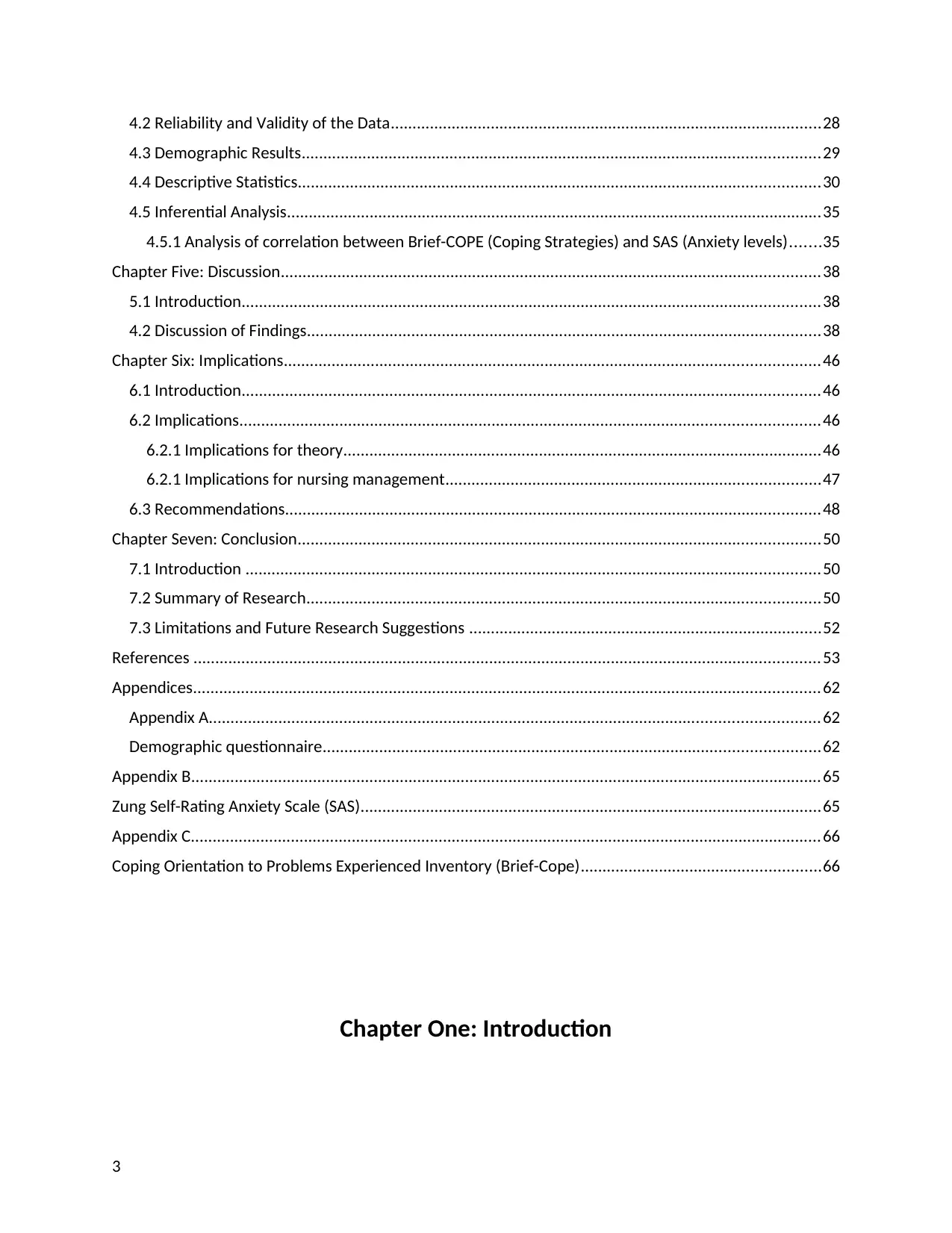
4.2 Reliability and Validity of the Data...................................................................................................28
4.3 Demographic Results.......................................................................................................................29
4.4 Descriptive Statistics........................................................................................................................30
4.5 Inferential Analysis...........................................................................................................................35
4.5.1 Analysis of correlation between Brief-COPE (Coping Strategies) and SAS (Anxiety levels).......35
Chapter Five: Discussion............................................................................................................................38
5.1 Introduction.....................................................................................................................................38
4.2 Discussion of Findings......................................................................................................................38
Chapter Six: Implications...........................................................................................................................46
6.1 Introduction.....................................................................................................................................46
6.2 Implications.....................................................................................................................................46
6.2.1 Implications for theory..............................................................................................................46
6.2.1 Implications for nursing management......................................................................................47
6.3 Recommendations...........................................................................................................................48
Chapter Seven: Conclusion........................................................................................................................50
7.1 Introduction ....................................................................................................................................50
7.2 Summary of Research......................................................................................................................50
7.3 Limitations and Future Research Suggestions .................................................................................52
References ................................................................................................................................................53
Appendices................................................................................................................................................62
Appendix A............................................................................................................................................62
Demographic questionnaire..................................................................................................................62
Appendix B.................................................................................................................................................65
Zung Self-Rating Anxiety Scale (SAS)..........................................................................................................65
Appendix C.................................................................................................................................................66
Coping Orientation to Problems Experienced Inventory (Brief-Cope).......................................................66
Chapter One: Introduction
3
4.3 Demographic Results.......................................................................................................................29
4.4 Descriptive Statistics........................................................................................................................30
4.5 Inferential Analysis...........................................................................................................................35
4.5.1 Analysis of correlation between Brief-COPE (Coping Strategies) and SAS (Anxiety levels).......35
Chapter Five: Discussion............................................................................................................................38
5.1 Introduction.....................................................................................................................................38
4.2 Discussion of Findings......................................................................................................................38
Chapter Six: Implications...........................................................................................................................46
6.1 Introduction.....................................................................................................................................46
6.2 Implications.....................................................................................................................................46
6.2.1 Implications for theory..............................................................................................................46
6.2.1 Implications for nursing management......................................................................................47
6.3 Recommendations...........................................................................................................................48
Chapter Seven: Conclusion........................................................................................................................50
7.1 Introduction ....................................................................................................................................50
7.2 Summary of Research......................................................................................................................50
7.3 Limitations and Future Research Suggestions .................................................................................52
References ................................................................................................................................................53
Appendices................................................................................................................................................62
Appendix A............................................................................................................................................62
Demographic questionnaire..................................................................................................................62
Appendix B.................................................................................................................................................65
Zung Self-Rating Anxiety Scale (SAS)..........................................................................................................65
Appendix C.................................................................................................................................................66
Coping Orientation to Problems Experienced Inventory (Brief-Cope).......................................................66
Chapter One: Introduction
3
⊘ This is a preview!⊘
Do you want full access?
Subscribe today to unlock all pages.

Trusted by 1+ million students worldwide
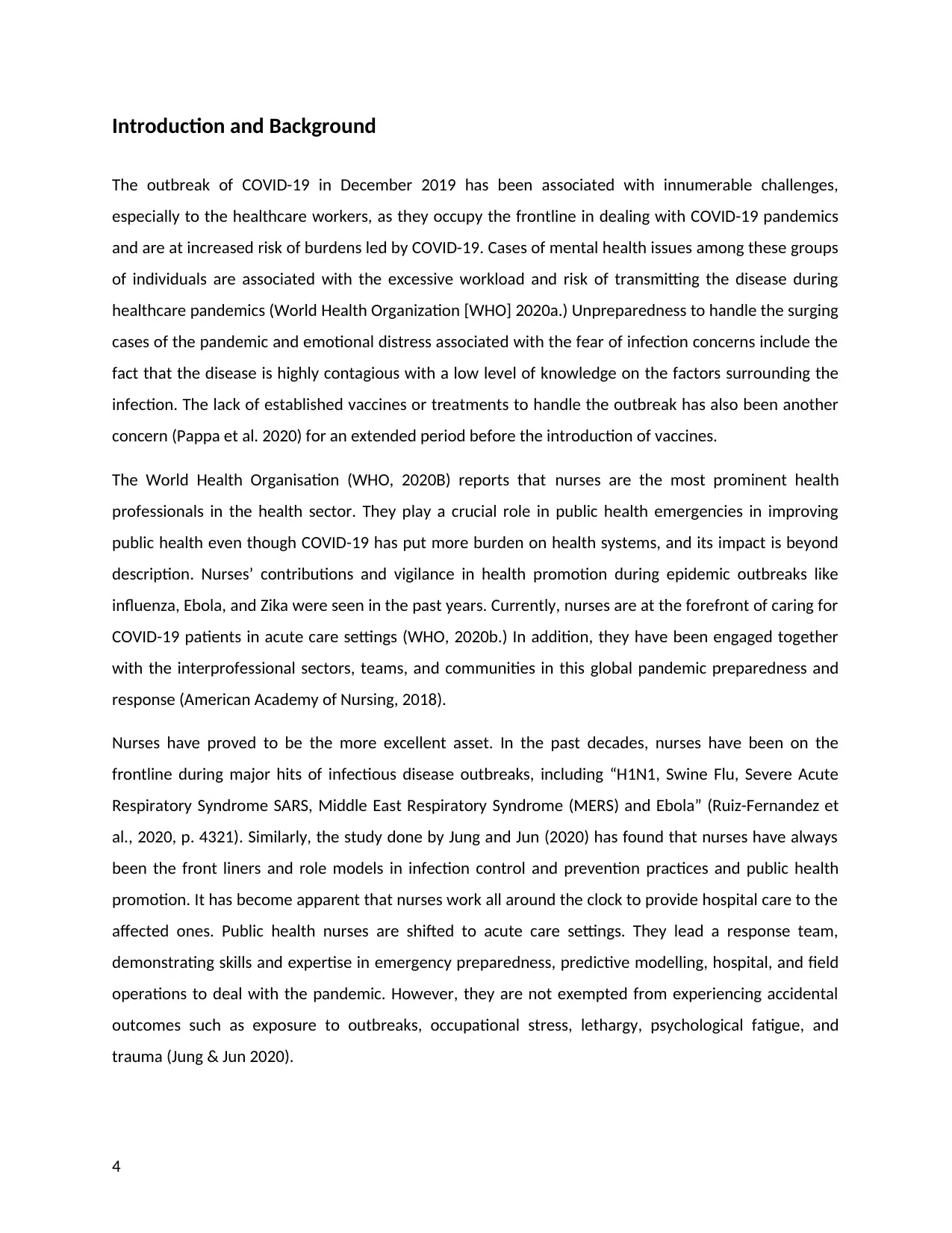
Introduction and Background
The outbreak of COVID-19 in December 2019 has been associated with innumerable challenges,
especially to the healthcare workers, as they occupy the frontline in dealing with COVID-19 pandemics
and are at increased risk of burdens led by COVID-19. Cases of mental health issues among these groups
of individuals are associated with the excessive workload and risk of transmitting the disease during
healthcare pandemics (World Health Organization [WHO] 2020a.) Unpreparedness to handle the surging
cases of the pandemic and emotional distress associated with the fear of infection concerns include the
fact that the disease is highly contagious with a low level of knowledge on the factors surrounding the
infection. The lack of established vaccines or treatments to handle the outbreak has also been another
concern (Pappa et al. 2020) for an extended period before the introduction of vaccines.
The World Health Organisation (WHO, 2020B) reports that nurses are the most prominent health
professionals in the health sector. They play a crucial role in public health emergencies in improving
public health even though COVID-19 has put more burden on health systems, and its impact is beyond
description. Nurses’ contributions and vigilance in health promotion during epidemic outbreaks like
influenza, Ebola, and Zika were seen in the past years. Currently, nurses are at the forefront of caring for
COVID-19 patients in acute care settings (WHO, 2020b.) In addition, they have been engaged together
with the interprofessional sectors, teams, and communities in this global pandemic preparedness and
response (American Academy of Nursing, 2018).
Nurses have proved to be the more excellent asset. In the past decades, nurses have been on the
frontline during major hits of infectious disease outbreaks, including “H1N1, Swine Flu, Severe Acute
Respiratory Syndrome SARS, Middle East Respiratory Syndrome (MERS) and Ebola” (Ruiz-Fernandez et
al., 2020, p. 4321). Similarly, the study done by Jung and Jun (2020) has found that nurses have always
been the front liners and role models in infection control and prevention practices and public health
promotion. It has become apparent that nurses work all around the clock to provide hospital care to the
affected ones. Public health nurses are shifted to acute care settings. They lead a response team,
demonstrating skills and expertise in emergency preparedness, predictive modelling, hospital, and field
operations to deal with the pandemic. However, they are not exempted from experiencing accidental
outcomes such as exposure to outbreaks, occupational stress, lethargy, psychological fatigue, and
trauma (Jung & Jun 2020).
4
The outbreak of COVID-19 in December 2019 has been associated with innumerable challenges,
especially to the healthcare workers, as they occupy the frontline in dealing with COVID-19 pandemics
and are at increased risk of burdens led by COVID-19. Cases of mental health issues among these groups
of individuals are associated with the excessive workload and risk of transmitting the disease during
healthcare pandemics (World Health Organization [WHO] 2020a.) Unpreparedness to handle the surging
cases of the pandemic and emotional distress associated with the fear of infection concerns include the
fact that the disease is highly contagious with a low level of knowledge on the factors surrounding the
infection. The lack of established vaccines or treatments to handle the outbreak has also been another
concern (Pappa et al. 2020) for an extended period before the introduction of vaccines.
The World Health Organisation (WHO, 2020B) reports that nurses are the most prominent health
professionals in the health sector. They play a crucial role in public health emergencies in improving
public health even though COVID-19 has put more burden on health systems, and its impact is beyond
description. Nurses’ contributions and vigilance in health promotion during epidemic outbreaks like
influenza, Ebola, and Zika were seen in the past years. Currently, nurses are at the forefront of caring for
COVID-19 patients in acute care settings (WHO, 2020b.) In addition, they have been engaged together
with the interprofessional sectors, teams, and communities in this global pandemic preparedness and
response (American Academy of Nursing, 2018).
Nurses have proved to be the more excellent asset. In the past decades, nurses have been on the
frontline during major hits of infectious disease outbreaks, including “H1N1, Swine Flu, Severe Acute
Respiratory Syndrome SARS, Middle East Respiratory Syndrome (MERS) and Ebola” (Ruiz-Fernandez et
al., 2020, p. 4321). Similarly, the study done by Jung and Jun (2020) has found that nurses have always
been the front liners and role models in infection control and prevention practices and public health
promotion. It has become apparent that nurses work all around the clock to provide hospital care to the
affected ones. Public health nurses are shifted to acute care settings. They lead a response team,
demonstrating skills and expertise in emergency preparedness, predictive modelling, hospital, and field
operations to deal with the pandemic. However, they are not exempted from experiencing accidental
outcomes such as exposure to outbreaks, occupational stress, lethargy, psychological fatigue, and
trauma (Jung & Jun 2020).
4
Paraphrase This Document
Need a fresh take? Get an instant paraphrase of this document with our AI Paraphraser
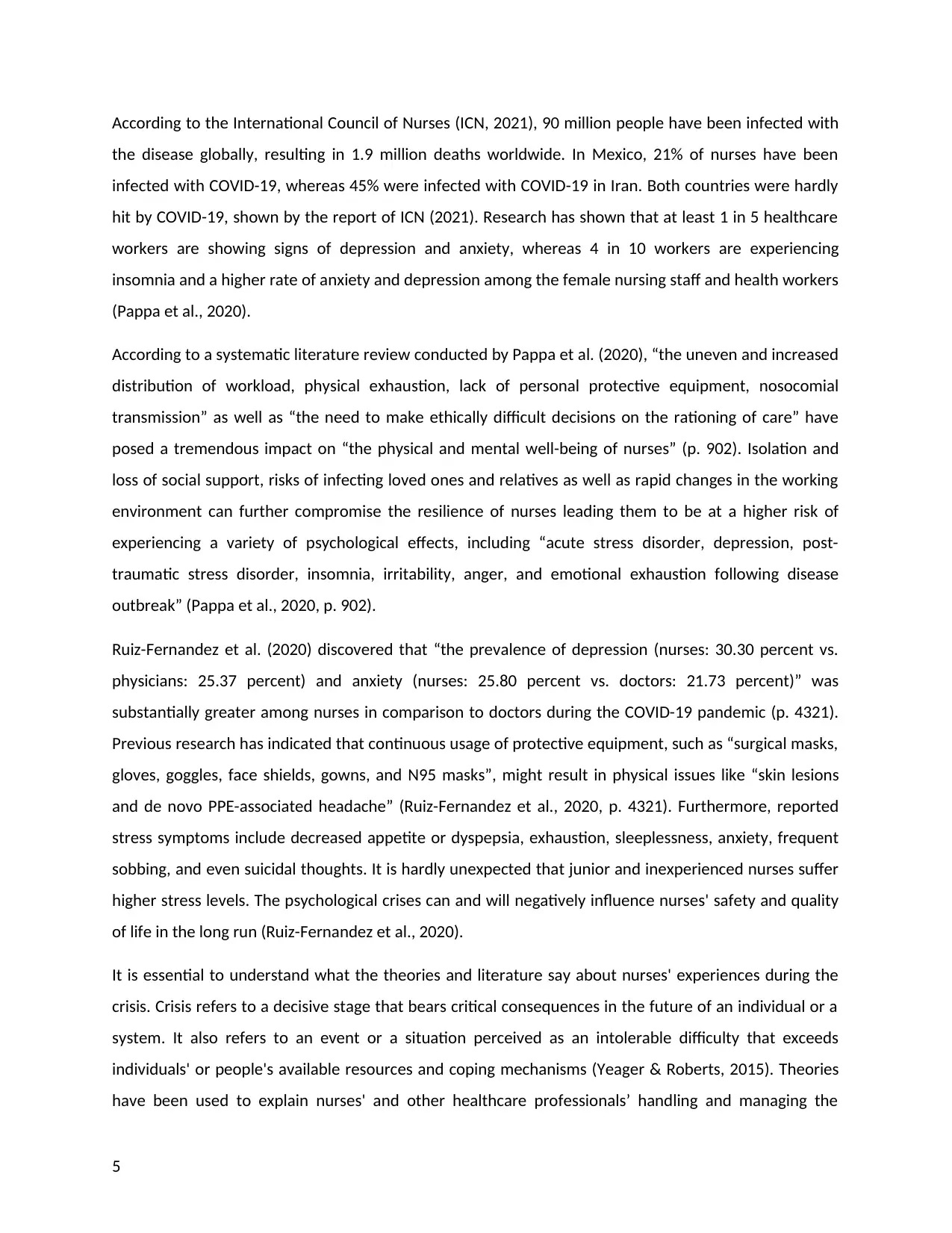
According to the International Council of Nurses (ICN, 2021), 90 million people have been infected with
the disease globally, resulting in 1.9 million deaths worldwide. In Mexico, 21% of nurses have been
infected with COVID-19, whereas 45% were infected with COVID-19 in Iran. Both countries were hardly
hit by COVID-19, shown by the report of ICN (2021). Research has shown that at least 1 in 5 healthcare
workers are showing signs of depression and anxiety, whereas 4 in 10 workers are experiencing
insomnia and a higher rate of anxiety and depression among the female nursing staff and health workers
(Pappa et al., 2020).
According to a systematic literature review conducted by Pappa et al. (2020), “the uneven and increased
distribution of workload, physical exhaustion, lack of personal protective equipment, nosocomial
transmission” as well as “the need to make ethically difficult decisions on the rationing of care” have
posed a tremendous impact on “the physical and mental well-being of nurses” (p. 902). Isolation and
loss of social support, risks of infecting loved ones and relatives as well as rapid changes in the working
environment can further compromise the resilience of nurses leading them to be at a higher risk of
experiencing a variety of psychological effects, including “acute stress disorder, depression, post-
traumatic stress disorder, insomnia, irritability, anger, and emotional exhaustion following disease
outbreak” (Pappa et al., 2020, p. 902).
Ruiz-Fernandez et al. (2020) discovered that “the prevalence of depression (nurses: 30.30 percent vs.
physicians: 25.37 percent) and anxiety (nurses: 25.80 percent vs. doctors: 21.73 percent)” was
substantially greater among nurses in comparison to doctors during the COVID-19 pandemic (p. 4321).
Previous research has indicated that continuous usage of protective equipment, such as “surgical masks,
gloves, goggles, face shields, gowns, and N95 masks”, might result in physical issues like “skin lesions
and de novo PPE-associated headache” (Ruiz-Fernandez et al., 2020, p. 4321). Furthermore, reported
stress symptoms include decreased appetite or dyspepsia, exhaustion, sleeplessness, anxiety, frequent
sobbing, and even suicidal thoughts. It is hardly unexpected that junior and inexperienced nurses suffer
higher stress levels. The psychological crises can and will negatively influence nurses' safety and quality
of life in the long run (Ruiz-Fernandez et al., 2020).
It is essential to understand what the theories and literature say about nurses' experiences during the
crisis. Crisis refers to a decisive stage that bears critical consequences in the future of an individual or a
system. It also refers to an event or a situation perceived as an intolerable difficulty that exceeds
individuals' or people's available resources and coping mechanisms (Yeager & Roberts, 2015). Theories
have been used to explain nurses' and other healthcare professionals’ handling and managing the
5
the disease globally, resulting in 1.9 million deaths worldwide. In Mexico, 21% of nurses have been
infected with COVID-19, whereas 45% were infected with COVID-19 in Iran. Both countries were hardly
hit by COVID-19, shown by the report of ICN (2021). Research has shown that at least 1 in 5 healthcare
workers are showing signs of depression and anxiety, whereas 4 in 10 workers are experiencing
insomnia and a higher rate of anxiety and depression among the female nursing staff and health workers
(Pappa et al., 2020).
According to a systematic literature review conducted by Pappa et al. (2020), “the uneven and increased
distribution of workload, physical exhaustion, lack of personal protective equipment, nosocomial
transmission” as well as “the need to make ethically difficult decisions on the rationing of care” have
posed a tremendous impact on “the physical and mental well-being of nurses” (p. 902). Isolation and
loss of social support, risks of infecting loved ones and relatives as well as rapid changes in the working
environment can further compromise the resilience of nurses leading them to be at a higher risk of
experiencing a variety of psychological effects, including “acute stress disorder, depression, post-
traumatic stress disorder, insomnia, irritability, anger, and emotional exhaustion following disease
outbreak” (Pappa et al., 2020, p. 902).
Ruiz-Fernandez et al. (2020) discovered that “the prevalence of depression (nurses: 30.30 percent vs.
physicians: 25.37 percent) and anxiety (nurses: 25.80 percent vs. doctors: 21.73 percent)” was
substantially greater among nurses in comparison to doctors during the COVID-19 pandemic (p. 4321).
Previous research has indicated that continuous usage of protective equipment, such as “surgical masks,
gloves, goggles, face shields, gowns, and N95 masks”, might result in physical issues like “skin lesions
and de novo PPE-associated headache” (Ruiz-Fernandez et al., 2020, p. 4321). Furthermore, reported
stress symptoms include decreased appetite or dyspepsia, exhaustion, sleeplessness, anxiety, frequent
sobbing, and even suicidal thoughts. It is hardly unexpected that junior and inexperienced nurses suffer
higher stress levels. The psychological crises can and will negatively influence nurses' safety and quality
of life in the long run (Ruiz-Fernandez et al., 2020).
It is essential to understand what the theories and literature say about nurses' experiences during the
crisis. Crisis refers to a decisive stage that bears critical consequences in the future of an individual or a
system. It also refers to an event or a situation perceived as an intolerable difficulty that exceeds
individuals' or people's available resources and coping mechanisms (Yeager & Roberts, 2015). Theories
have been used to explain nurses' and other healthcare professionals’ handling and managing the
5
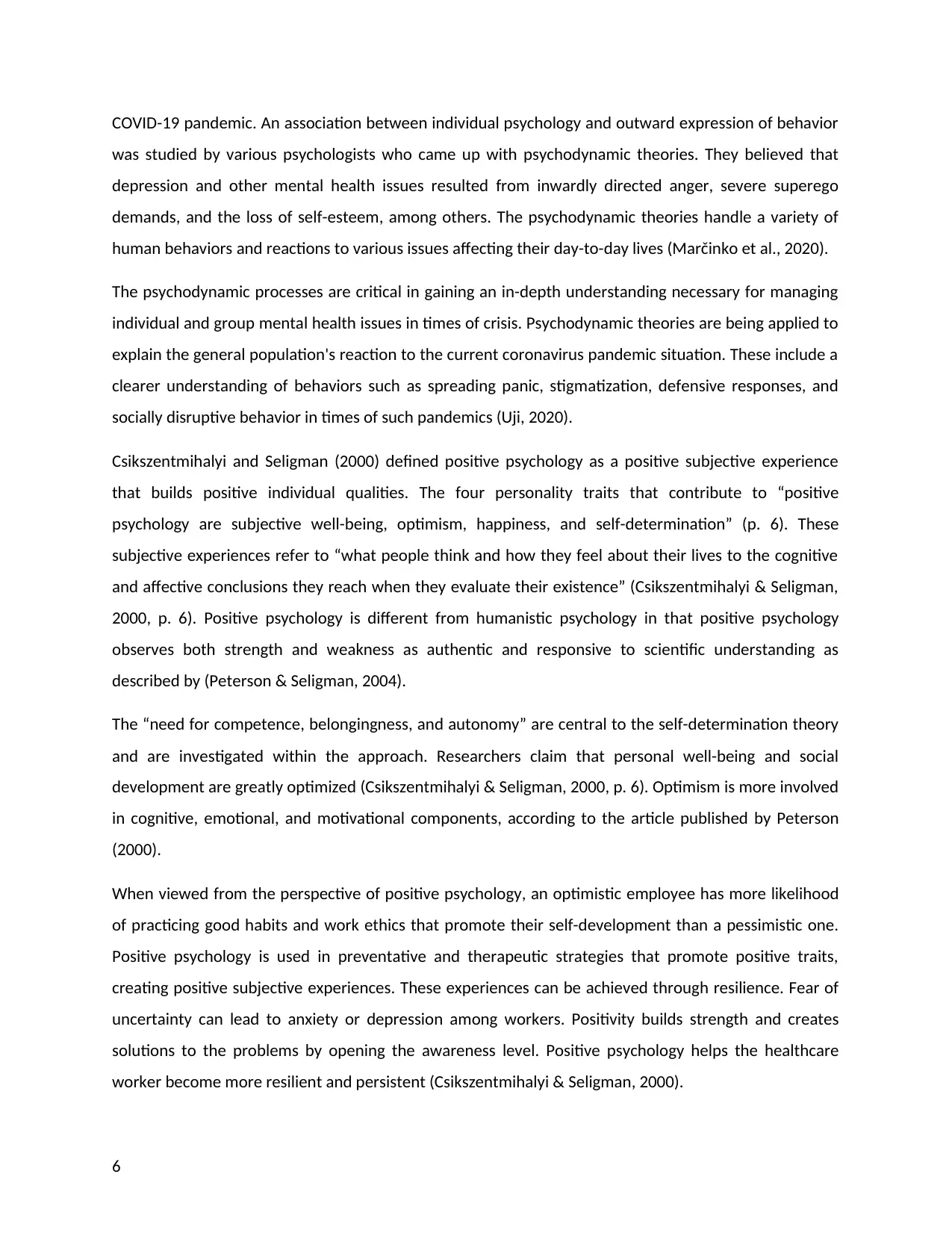
COVID-19 pandemic. An association between individual psychology and outward expression of behavior
was studied by various psychologists who came up with psychodynamic theories. They believed that
depression and other mental health issues resulted from inwardly directed anger, severe superego
demands, and the loss of self-esteem, among others. The psychodynamic theories handle a variety of
human behaviors and reactions to various issues affecting their day-to-day lives (Marčinko et al., 2020).
The psychodynamic processes are critical in gaining an in-depth understanding necessary for managing
individual and group mental health issues in times of crisis. Psychodynamic theories are being applied to
explain the general population's reaction to the current coronavirus pandemic situation. These include a
clearer understanding of behaviors such as spreading panic, stigmatization, defensive responses, and
socially disruptive behavior in times of such pandemics (Uji, 2020).
Csikszentmihalyi and Seligman (2000) defined positive psychology as a positive subjective experience
that builds positive individual qualities. The four personality traits that contribute to “positive
psychology are subjective well-being, optimism, happiness, and self-determination” (p. 6). These
subjective experiences refer to “what people think and how they feel about their lives to the cognitive
and affective conclusions they reach when they evaluate their existence” (Csikszentmihalyi & Seligman,
2000, p. 6). Positive psychology is different from humanistic psychology in that positive psychology
observes both strength and weakness as authentic and responsive to scientific understanding as
described by (Peterson & Seligman, 2004).
The “need for competence, belongingness, and autonomy” are central to the self-determination theory
and are investigated within the approach. Researchers claim that personal well-being and social
development are greatly optimized (Csikszentmihalyi & Seligman, 2000, p. 6). Optimism is more involved
in cognitive, emotional, and motivational components, according to the article published by Peterson
(2000).
When viewed from the perspective of positive psychology, an optimistic employee has more likelihood
of practicing good habits and work ethics that promote their self-development than a pessimistic one.
Positive psychology is used in preventative and therapeutic strategies that promote positive traits,
creating positive subjective experiences. These experiences can be achieved through resilience. Fear of
uncertainty can lead to anxiety or depression among workers. Positivity builds strength and creates
solutions to the problems by opening the awareness level. Positive psychology helps the healthcare
worker become more resilient and persistent (Csikszentmihalyi & Seligman, 2000).
6
was studied by various psychologists who came up with psychodynamic theories. They believed that
depression and other mental health issues resulted from inwardly directed anger, severe superego
demands, and the loss of self-esteem, among others. The psychodynamic theories handle a variety of
human behaviors and reactions to various issues affecting their day-to-day lives (Marčinko et al., 2020).
The psychodynamic processes are critical in gaining an in-depth understanding necessary for managing
individual and group mental health issues in times of crisis. Psychodynamic theories are being applied to
explain the general population's reaction to the current coronavirus pandemic situation. These include a
clearer understanding of behaviors such as spreading panic, stigmatization, defensive responses, and
socially disruptive behavior in times of such pandemics (Uji, 2020).
Csikszentmihalyi and Seligman (2000) defined positive psychology as a positive subjective experience
that builds positive individual qualities. The four personality traits that contribute to “positive
psychology are subjective well-being, optimism, happiness, and self-determination” (p. 6). These
subjective experiences refer to “what people think and how they feel about their lives to the cognitive
and affective conclusions they reach when they evaluate their existence” (Csikszentmihalyi & Seligman,
2000, p. 6). Positive psychology is different from humanistic psychology in that positive psychology
observes both strength and weakness as authentic and responsive to scientific understanding as
described by (Peterson & Seligman, 2004).
The “need for competence, belongingness, and autonomy” are central to the self-determination theory
and are investigated within the approach. Researchers claim that personal well-being and social
development are greatly optimized (Csikszentmihalyi & Seligman, 2000, p. 6). Optimism is more involved
in cognitive, emotional, and motivational components, according to the article published by Peterson
(2000).
When viewed from the perspective of positive psychology, an optimistic employee has more likelihood
of practicing good habits and work ethics that promote their self-development than a pessimistic one.
Positive psychology is used in preventative and therapeutic strategies that promote positive traits,
creating positive subjective experiences. These experiences can be achieved through resilience. Fear of
uncertainty can lead to anxiety or depression among workers. Positivity builds strength and creates
solutions to the problems by opening the awareness level. Positive psychology helps the healthcare
worker become more resilient and persistent (Csikszentmihalyi & Seligman, 2000).
6
⊘ This is a preview!⊘
Do you want full access?
Subscribe today to unlock all pages.

Trusted by 1+ million students worldwide
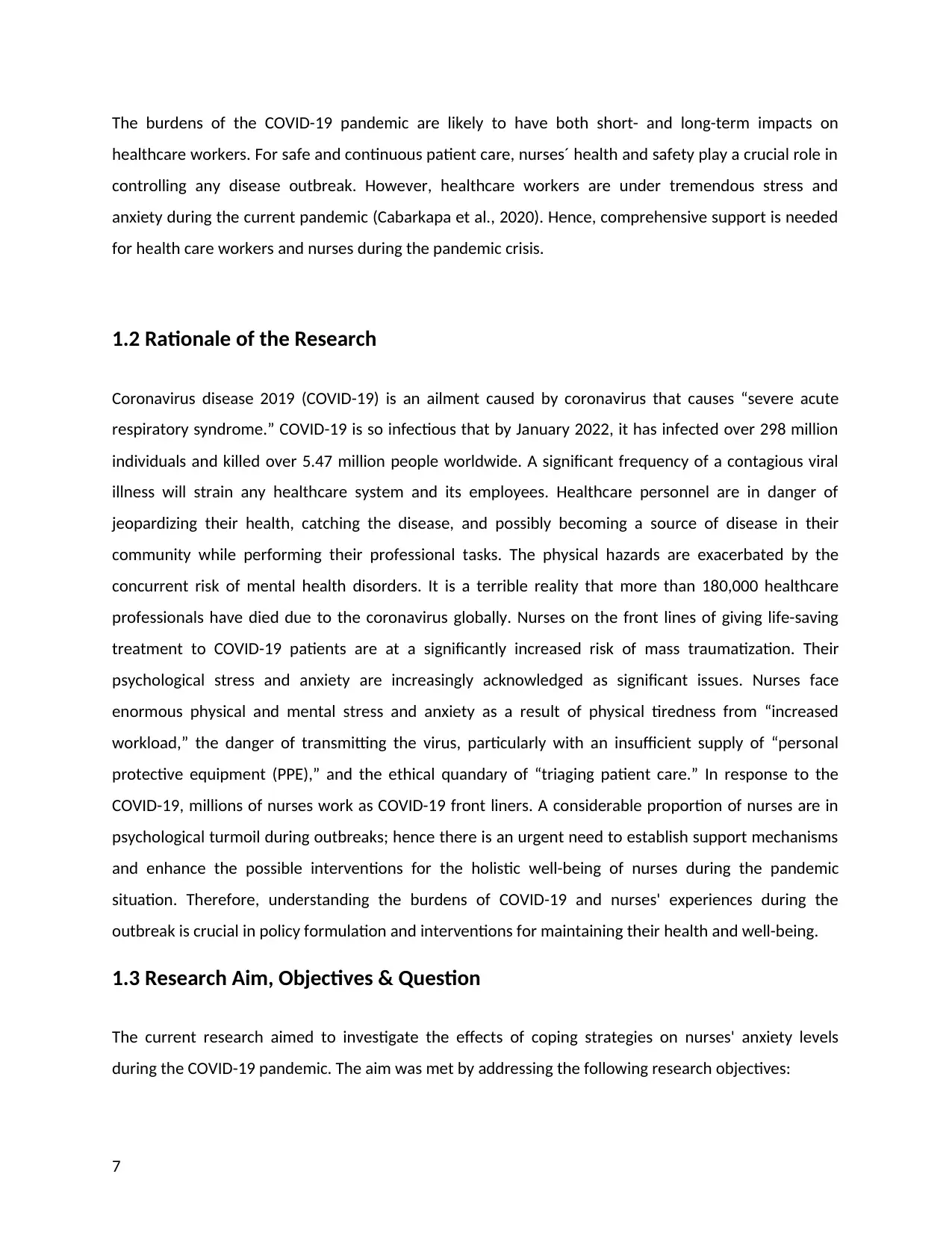
The burdens of the COVID-19 pandemic are likely to have both short- and long-term impacts on
healthcare workers. For safe and continuous patient care, nurses´ health and safety play a crucial role in
controlling any disease outbreak. However, healthcare workers are under tremendous stress and
anxiety during the current pandemic (Cabarkapa et al., 2020). Hence, comprehensive support is needed
for health care workers and nurses during the pandemic crisis.
1.2 Rationale of the Research
Coronavirus disease 2019 (COVID-19) is an ailment caused by coronavirus that causes “severe acute
respiratory syndrome.” COVID-19 is so infectious that by January 2022, it has infected over 298 million
individuals and killed over 5.47 million people worldwide. A significant frequency of a contagious viral
illness will strain any healthcare system and its employees. Healthcare personnel are in danger of
jeopardizing their health, catching the disease, and possibly becoming a source of disease in their
community while performing their professional tasks. The physical hazards are exacerbated by the
concurrent risk of mental health disorders. It is a terrible reality that more than 180,000 healthcare
professionals have died due to the coronavirus globally. Nurses on the front lines of giving life-saving
treatment to COVID-19 patients are at a significantly increased risk of mass traumatization. Their
psychological stress and anxiety are increasingly acknowledged as significant issues. Nurses face
enormous physical and mental stress and anxiety as a result of physical tiredness from “increased
workload,” the danger of transmitting the virus, particularly with an insufficient supply of “personal
protective equipment (PPE),” and the ethical quandary of “triaging patient care.” In response to the
COVID-19, millions of nurses work as COVID-19 front liners. A considerable proportion of nurses are in
psychological turmoil during outbreaks; hence there is an urgent need to establish support mechanisms
and enhance the possible interventions for the holistic well-being of nurses during the pandemic
situation. Therefore, understanding the burdens of COVID-19 and nurses' experiences during the
outbreak is crucial in policy formulation and interventions for maintaining their health and well-being.
1.3 Research Aim, Objectives & Question
The current research aimed to investigate the effects of coping strategies on nurses' anxiety levels
during the COVID-19 pandemic. The aim was met by addressing the following research objectives:
7
healthcare workers. For safe and continuous patient care, nurses´ health and safety play a crucial role in
controlling any disease outbreak. However, healthcare workers are under tremendous stress and
anxiety during the current pandemic (Cabarkapa et al., 2020). Hence, comprehensive support is needed
for health care workers and nurses during the pandemic crisis.
1.2 Rationale of the Research
Coronavirus disease 2019 (COVID-19) is an ailment caused by coronavirus that causes “severe acute
respiratory syndrome.” COVID-19 is so infectious that by January 2022, it has infected over 298 million
individuals and killed over 5.47 million people worldwide. A significant frequency of a contagious viral
illness will strain any healthcare system and its employees. Healthcare personnel are in danger of
jeopardizing their health, catching the disease, and possibly becoming a source of disease in their
community while performing their professional tasks. The physical hazards are exacerbated by the
concurrent risk of mental health disorders. It is a terrible reality that more than 180,000 healthcare
professionals have died due to the coronavirus globally. Nurses on the front lines of giving life-saving
treatment to COVID-19 patients are at a significantly increased risk of mass traumatization. Their
psychological stress and anxiety are increasingly acknowledged as significant issues. Nurses face
enormous physical and mental stress and anxiety as a result of physical tiredness from “increased
workload,” the danger of transmitting the virus, particularly with an insufficient supply of “personal
protective equipment (PPE),” and the ethical quandary of “triaging patient care.” In response to the
COVID-19, millions of nurses work as COVID-19 front liners. A considerable proportion of nurses are in
psychological turmoil during outbreaks; hence there is an urgent need to establish support mechanisms
and enhance the possible interventions for the holistic well-being of nurses during the pandemic
situation. Therefore, understanding the burdens of COVID-19 and nurses' experiences during the
outbreak is crucial in policy formulation and interventions for maintaining their health and well-being.
1.3 Research Aim, Objectives & Question
The current research aimed to investigate the effects of coping strategies on nurses' anxiety levels
during the COVID-19 pandemic. The aim was met by addressing the following research objectives:
7
Paraphrase This Document
Need a fresh take? Get an instant paraphrase of this document with our AI Paraphraser
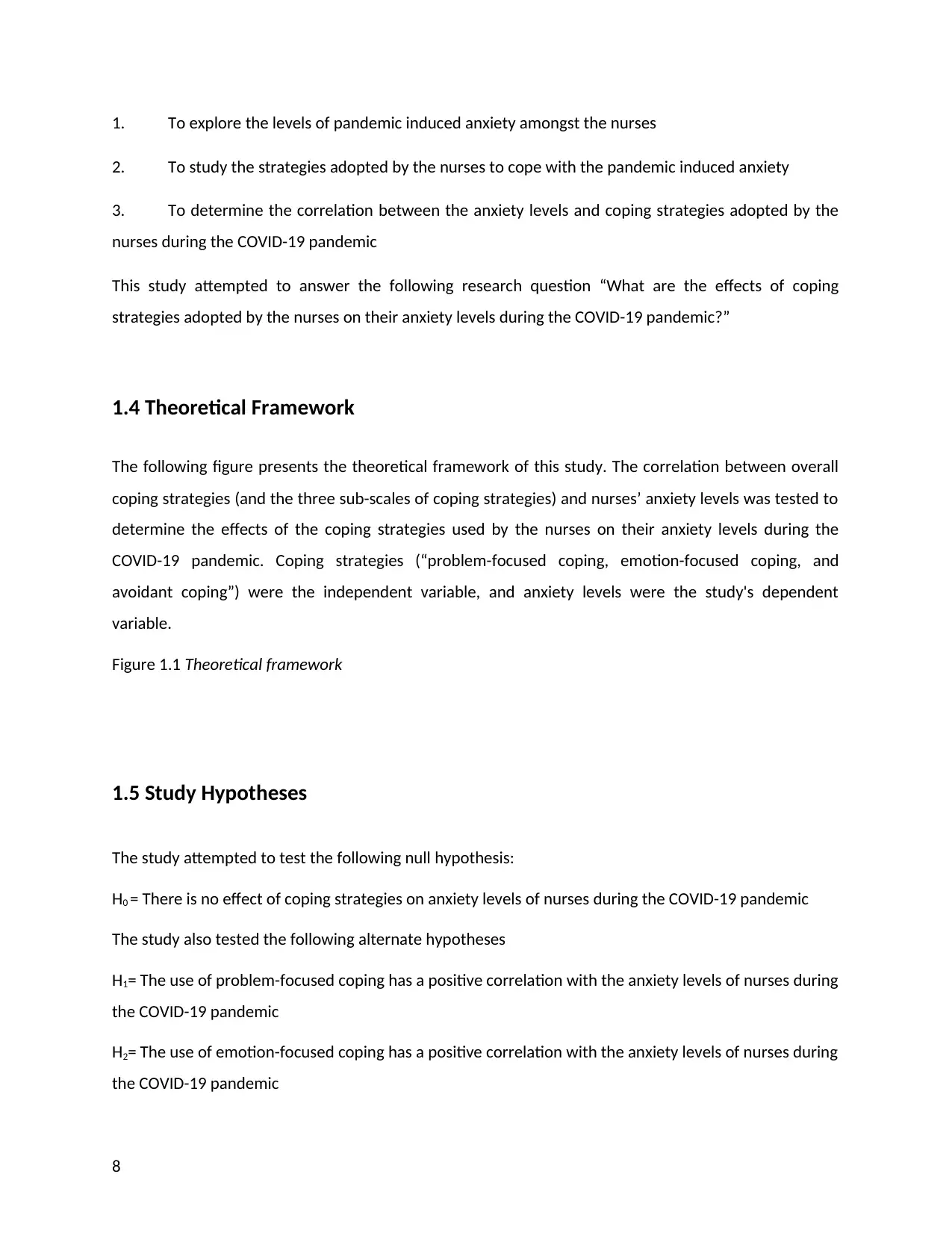
1. To explore the levels of pandemic induced anxiety amongst the nurses
2. To study the strategies adopted by the nurses to cope with the pandemic induced anxiety
3. To determine the correlation between the anxiety levels and coping strategies adopted by the
nurses during the COVID-19 pandemic
This study attempted to answer the following research question “What are the effects of coping
strategies adopted by the nurses on their anxiety levels during the COVID-19 pandemic?”
1.4 Theoretical Framework
The following figure presents the theoretical framework of this study. The correlation between overall
coping strategies (and the three sub-scales of coping strategies) and nurses’ anxiety levels was tested to
determine the effects of the coping strategies used by the nurses on their anxiety levels during the
COVID-19 pandemic. Coping strategies (“problem-focused coping, emotion-focused coping, and
avoidant coping”) were the independent variable, and anxiety levels were the study's dependent
variable.
Figure 1.1 Theoretical framework
1.5 Study Hypotheses
The study attempted to test the following null hypothesis:
H0 = There is no effect of coping strategies on anxiety levels of nurses during the COVID-19 pandemic
The study also tested the following alternate hypotheses
H1= The use of problem-focused coping has a positive correlation with the anxiety levels of nurses during
the COVID-19 pandemic
H2= The use of emotion-focused coping has a positive correlation with the anxiety levels of nurses during
the COVID-19 pandemic
8
2. To study the strategies adopted by the nurses to cope with the pandemic induced anxiety
3. To determine the correlation between the anxiety levels and coping strategies adopted by the
nurses during the COVID-19 pandemic
This study attempted to answer the following research question “What are the effects of coping
strategies adopted by the nurses on their anxiety levels during the COVID-19 pandemic?”
1.4 Theoretical Framework
The following figure presents the theoretical framework of this study. The correlation between overall
coping strategies (and the three sub-scales of coping strategies) and nurses’ anxiety levels was tested to
determine the effects of the coping strategies used by the nurses on their anxiety levels during the
COVID-19 pandemic. Coping strategies (“problem-focused coping, emotion-focused coping, and
avoidant coping”) were the independent variable, and anxiety levels were the study's dependent
variable.
Figure 1.1 Theoretical framework
1.5 Study Hypotheses
The study attempted to test the following null hypothesis:
H0 = There is no effect of coping strategies on anxiety levels of nurses during the COVID-19 pandemic
The study also tested the following alternate hypotheses
H1= The use of problem-focused coping has a positive correlation with the anxiety levels of nurses during
the COVID-19 pandemic
H2= The use of emotion-focused coping has a positive correlation with the anxiety levels of nurses during
the COVID-19 pandemic
8

H3= The use of avoidant coping has a positive correlation with the anxiety levels of nurses during the
COVID-19 pandemic
The use of (specific) coping strategies will correlate with lowering anxiety levels and vice versa.
1.6 Outline of the Dissertation
Chapter one has provided a background to the study; study rationale; theoretical framework; research
aim, objectives, and question; and an outline of the dissertation. Chapter two consists of a review of the
existing literature on the research problem and ends at identifying a research gap that will be filled by
meeting the objectives of the current study. Chapter three offers an account of the decisions made by
the researcher regarding the way the research was conducted, that is, research methods. The chapter
includes sections on the justification for research design, study population and sample size, research
instrument, an explanation of the research process, and a discussion of ethical aspects and reliability
and validity.
Chapter four presents the results of the study. Chapter five consists of a discussion on the findings of the
study. The implications of the study findings are examined in the context of the discipline in chapter six.
Implications for theory, policy, and practice are addressed, and policy and practice recommendations
are in chapter six. Chapter seven includes a critical examination of the study’s limitations and
suggestions for future research.
Chapter Two: Literature Review
2.1 Introduction
Since this study is concerned with anxiety levels and coping strategies employed by nurses during the
COVID-19 pandemic, this chapter begins with an elucidation of the notion of anxiety. It explores how
this phenomenon affects healthcare professionals during COVID-19 in general. The chapter then heads
on to look at nurses' anxiety levels during COVID-19. Finally, the coping strategies utilized by the nurses
to overcome anxiety are discussed in the light of existing literature on the notion. The chapter ends with
identifying a research gap that will be filled by addressing the objectives of the current study.
9
COVID-19 pandemic
The use of (specific) coping strategies will correlate with lowering anxiety levels and vice versa.
1.6 Outline of the Dissertation
Chapter one has provided a background to the study; study rationale; theoretical framework; research
aim, objectives, and question; and an outline of the dissertation. Chapter two consists of a review of the
existing literature on the research problem and ends at identifying a research gap that will be filled by
meeting the objectives of the current study. Chapter three offers an account of the decisions made by
the researcher regarding the way the research was conducted, that is, research methods. The chapter
includes sections on the justification for research design, study population and sample size, research
instrument, an explanation of the research process, and a discussion of ethical aspects and reliability
and validity.
Chapter four presents the results of the study. Chapter five consists of a discussion on the findings of the
study. The implications of the study findings are examined in the context of the discipline in chapter six.
Implications for theory, policy, and practice are addressed, and policy and practice recommendations
are in chapter six. Chapter seven includes a critical examination of the study’s limitations and
suggestions for future research.
Chapter Two: Literature Review
2.1 Introduction
Since this study is concerned with anxiety levels and coping strategies employed by nurses during the
COVID-19 pandemic, this chapter begins with an elucidation of the notion of anxiety. It explores how
this phenomenon affects healthcare professionals during COVID-19 in general. The chapter then heads
on to look at nurses' anxiety levels during COVID-19. Finally, the coping strategies utilized by the nurses
to overcome anxiety are discussed in the light of existing literature on the notion. The chapter ends with
identifying a research gap that will be filled by addressing the objectives of the current study.
9
⊘ This is a preview!⊘
Do you want full access?
Subscribe today to unlock all pages.

Trusted by 1+ million students worldwide
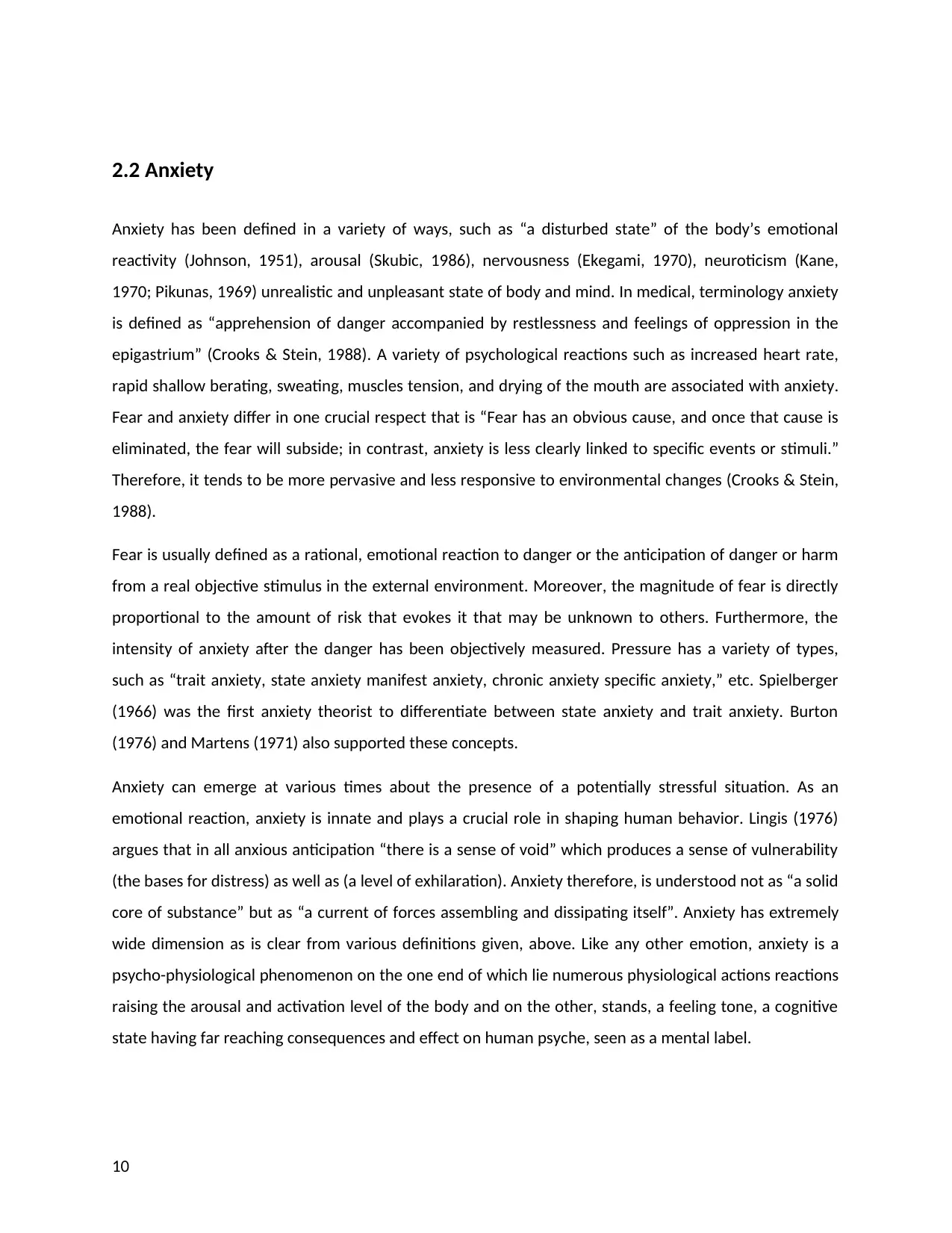
2.2 Anxiety
Anxiety has been defined in a variety of ways, such as “a disturbed state” of the body’s emotional
reactivity (Johnson, 1951), arousal (Skubic, 1986), nervousness (Ekegami, 1970), neuroticism (Kane,
1970; Pikunas, 1969) unrealistic and unpleasant state of body and mind. In medical, terminology anxiety
is defined as “apprehension of danger accompanied by restlessness and feelings of oppression in the
epigastrium” (Crooks & Stein, 1988). A variety of psychological reactions such as increased heart rate,
rapid shallow berating, sweating, muscles tension, and drying of the mouth are associated with anxiety.
Fear and anxiety differ in one crucial respect that is “Fear has an obvious cause, and once that cause is
eliminated, the fear will subside; in contrast, anxiety is less clearly linked to specific events or stimuli.”
Therefore, it tends to be more pervasive and less responsive to environmental changes (Crooks & Stein,
1988).
Fear is usually defined as a rational, emotional reaction to danger or the anticipation of danger or harm
from a real objective stimulus in the external environment. Moreover, the magnitude of fear is directly
proportional to the amount of risk that evokes it that may be unknown to others. Furthermore, the
intensity of anxiety after the danger has been objectively measured. Pressure has a variety of types,
such as “trait anxiety, state anxiety manifest anxiety, chronic anxiety specific anxiety,” etc. Spielberger
(1966) was the first anxiety theorist to differentiate between state anxiety and trait anxiety. Burton
(1976) and Martens (1971) also supported these concepts.
Anxiety can emerge at various times about the presence of a potentially stressful situation. As an
emotional reaction, anxiety is innate and plays a crucial role in shaping human behavior. Lingis (1976)
argues that in all anxious anticipation “there is a sense of void” which produces a sense of vulnerability
(the bases for distress) as well as (a level of exhilaration). Anxiety therefore, is understood not as “a solid
core of substance” but as “a current of forces assembling and dissipating itself”. Anxiety has extremely
wide dimension as is clear from various definitions given, above. Like any other emotion, anxiety is a
psycho-physiological phenomenon on the one end of which lie numerous physiological actions reactions
raising the arousal and activation level of the body and on the other, stands, a feeling tone, a cognitive
state having far reaching consequences and effect on human psyche, seen as a mental label.
10
Anxiety has been defined in a variety of ways, such as “a disturbed state” of the body’s emotional
reactivity (Johnson, 1951), arousal (Skubic, 1986), nervousness (Ekegami, 1970), neuroticism (Kane,
1970; Pikunas, 1969) unrealistic and unpleasant state of body and mind. In medical, terminology anxiety
is defined as “apprehension of danger accompanied by restlessness and feelings of oppression in the
epigastrium” (Crooks & Stein, 1988). A variety of psychological reactions such as increased heart rate,
rapid shallow berating, sweating, muscles tension, and drying of the mouth are associated with anxiety.
Fear and anxiety differ in one crucial respect that is “Fear has an obvious cause, and once that cause is
eliminated, the fear will subside; in contrast, anxiety is less clearly linked to specific events or stimuli.”
Therefore, it tends to be more pervasive and less responsive to environmental changes (Crooks & Stein,
1988).
Fear is usually defined as a rational, emotional reaction to danger or the anticipation of danger or harm
from a real objective stimulus in the external environment. Moreover, the magnitude of fear is directly
proportional to the amount of risk that evokes it that may be unknown to others. Furthermore, the
intensity of anxiety after the danger has been objectively measured. Pressure has a variety of types,
such as “trait anxiety, state anxiety manifest anxiety, chronic anxiety specific anxiety,” etc. Spielberger
(1966) was the first anxiety theorist to differentiate between state anxiety and trait anxiety. Burton
(1976) and Martens (1971) also supported these concepts.
Anxiety can emerge at various times about the presence of a potentially stressful situation. As an
emotional reaction, anxiety is innate and plays a crucial role in shaping human behavior. Lingis (1976)
argues that in all anxious anticipation “there is a sense of void” which produces a sense of vulnerability
(the bases for distress) as well as (a level of exhilaration). Anxiety therefore, is understood not as “a solid
core of substance” but as “a current of forces assembling and dissipating itself”. Anxiety has extremely
wide dimension as is clear from various definitions given, above. Like any other emotion, anxiety is a
psycho-physiological phenomenon on the one end of which lie numerous physiological actions reactions
raising the arousal and activation level of the body and on the other, stands, a feeling tone, a cognitive
state having far reaching consequences and effect on human psyche, seen as a mental label.
10
Paraphrase This Document
Need a fresh take? Get an instant paraphrase of this document with our AI Paraphraser
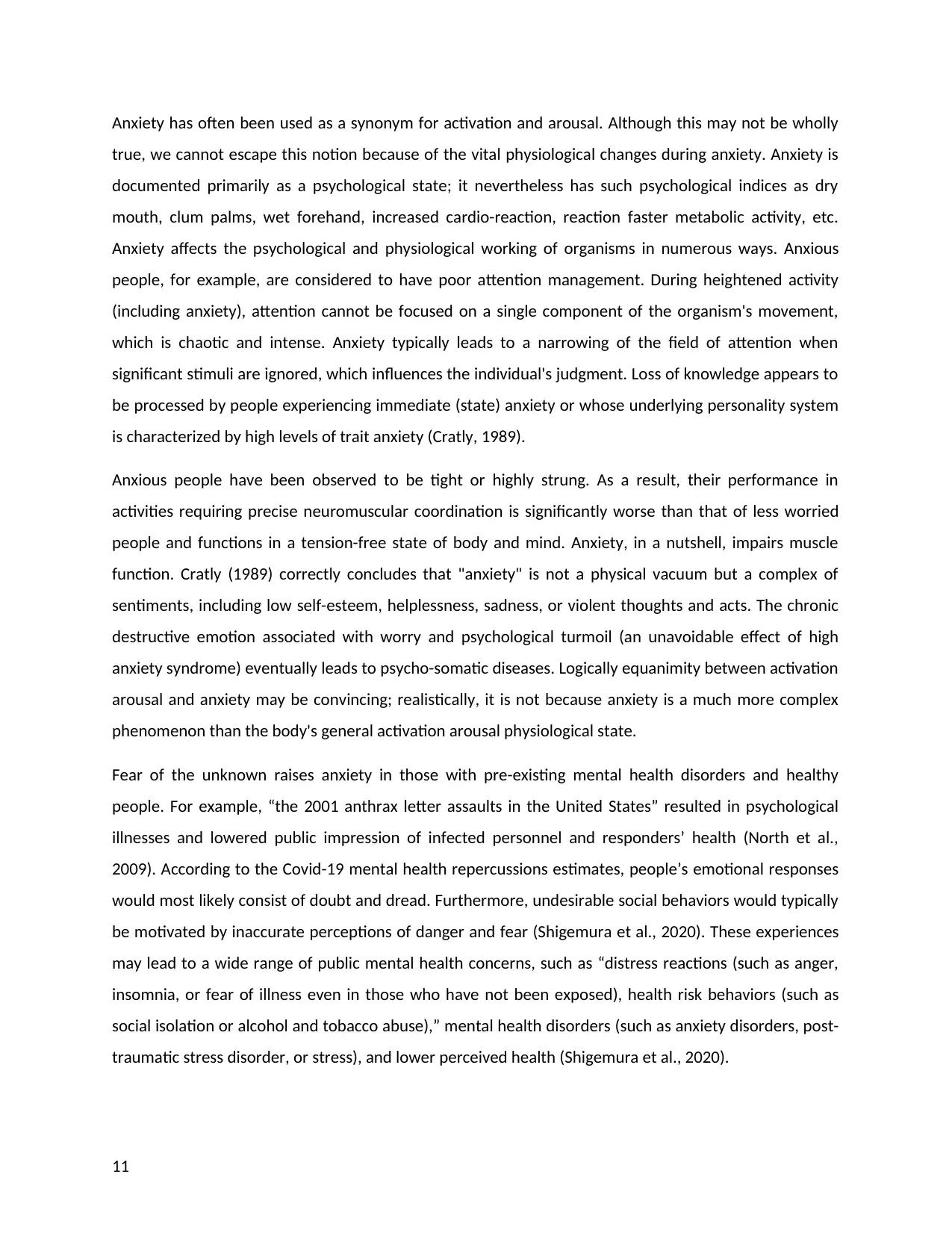
Anxiety has often been used as a synonym for activation and arousal. Although this may not be wholly
true, we cannot escape this notion because of the vital physiological changes during anxiety. Anxiety is
documented primarily as a psychological state; it nevertheless has such psychological indices as dry
mouth, clum palms, wet forehand, increased cardio-reaction, reaction faster metabolic activity, etc.
Anxiety affects the psychological and physiological working of organisms in numerous ways. Anxious
people, for example, are considered to have poor attention management. During heightened activity
(including anxiety), attention cannot be focused on a single component of the organism's movement,
which is chaotic and intense. Anxiety typically leads to a narrowing of the field of attention when
significant stimuli are ignored, which influences the individual's judgment. Loss of knowledge appears to
be processed by people experiencing immediate (state) anxiety or whose underlying personality system
is characterized by high levels of trait anxiety (Cratly, 1989).
Anxious people have been observed to be tight or highly strung. As a result, their performance in
activities requiring precise neuromuscular coordination is significantly worse than that of less worried
people and functions in a tension-free state of body and mind. Anxiety, in a nutshell, impairs muscle
function. Cratly (1989) correctly concludes that "anxiety" is not a physical vacuum but a complex of
sentiments, including low self-esteem, helplessness, sadness, or violent thoughts and acts. The chronic
destructive emotion associated with worry and psychological turmoil (an unavoidable effect of high
anxiety syndrome) eventually leads to psycho-somatic diseases. Logically equanimity between activation
arousal and anxiety may be convincing; realistically, it is not because anxiety is a much more complex
phenomenon than the body's general activation arousal physiological state.
Fear of the unknown raises anxiety in those with pre-existing mental health disorders and healthy
people. For example, “the 2001 anthrax letter assaults in the United States” resulted in psychological
illnesses and lowered public impression of infected personnel and responders’ health (North et al.,
2009). According to the Covid-19 mental health repercussions estimates, people’s emotional responses
would most likely consist of doubt and dread. Furthermore, undesirable social behaviors would typically
be motivated by inaccurate perceptions of danger and fear (Shigemura et al., 2020). These experiences
may lead to a wide range of public mental health concerns, such as “distress reactions (such as anger,
insomnia, or fear of illness even in those who have not been exposed), health risk behaviors (such as
social isolation or alcohol and tobacco abuse),” mental health disorders (such as anxiety disorders, post-
traumatic stress disorder, or stress), and lower perceived health (Shigemura et al., 2020).
11
true, we cannot escape this notion because of the vital physiological changes during anxiety. Anxiety is
documented primarily as a psychological state; it nevertheless has such psychological indices as dry
mouth, clum palms, wet forehand, increased cardio-reaction, reaction faster metabolic activity, etc.
Anxiety affects the psychological and physiological working of organisms in numerous ways. Anxious
people, for example, are considered to have poor attention management. During heightened activity
(including anxiety), attention cannot be focused on a single component of the organism's movement,
which is chaotic and intense. Anxiety typically leads to a narrowing of the field of attention when
significant stimuli are ignored, which influences the individual's judgment. Loss of knowledge appears to
be processed by people experiencing immediate (state) anxiety or whose underlying personality system
is characterized by high levels of trait anxiety (Cratly, 1989).
Anxious people have been observed to be tight or highly strung. As a result, their performance in
activities requiring precise neuromuscular coordination is significantly worse than that of less worried
people and functions in a tension-free state of body and mind. Anxiety, in a nutshell, impairs muscle
function. Cratly (1989) correctly concludes that "anxiety" is not a physical vacuum but a complex of
sentiments, including low self-esteem, helplessness, sadness, or violent thoughts and acts. The chronic
destructive emotion associated with worry and psychological turmoil (an unavoidable effect of high
anxiety syndrome) eventually leads to psycho-somatic diseases. Logically equanimity between activation
arousal and anxiety may be convincing; realistically, it is not because anxiety is a much more complex
phenomenon than the body's general activation arousal physiological state.
Fear of the unknown raises anxiety in those with pre-existing mental health disorders and healthy
people. For example, “the 2001 anthrax letter assaults in the United States” resulted in psychological
illnesses and lowered public impression of infected personnel and responders’ health (North et al.,
2009). According to the Covid-19 mental health repercussions estimates, people’s emotional responses
would most likely consist of doubt and dread. Furthermore, undesirable social behaviors would typically
be motivated by inaccurate perceptions of danger and fear (Shigemura et al., 2020). These experiences
may lead to a wide range of public mental health concerns, such as “distress reactions (such as anger,
insomnia, or fear of illness even in those who have not been exposed), health risk behaviors (such as
social isolation or alcohol and tobacco abuse),” mental health disorders (such as anxiety disorders, post-
traumatic stress disorder, or stress), and lower perceived health (Shigemura et al., 2020).
11
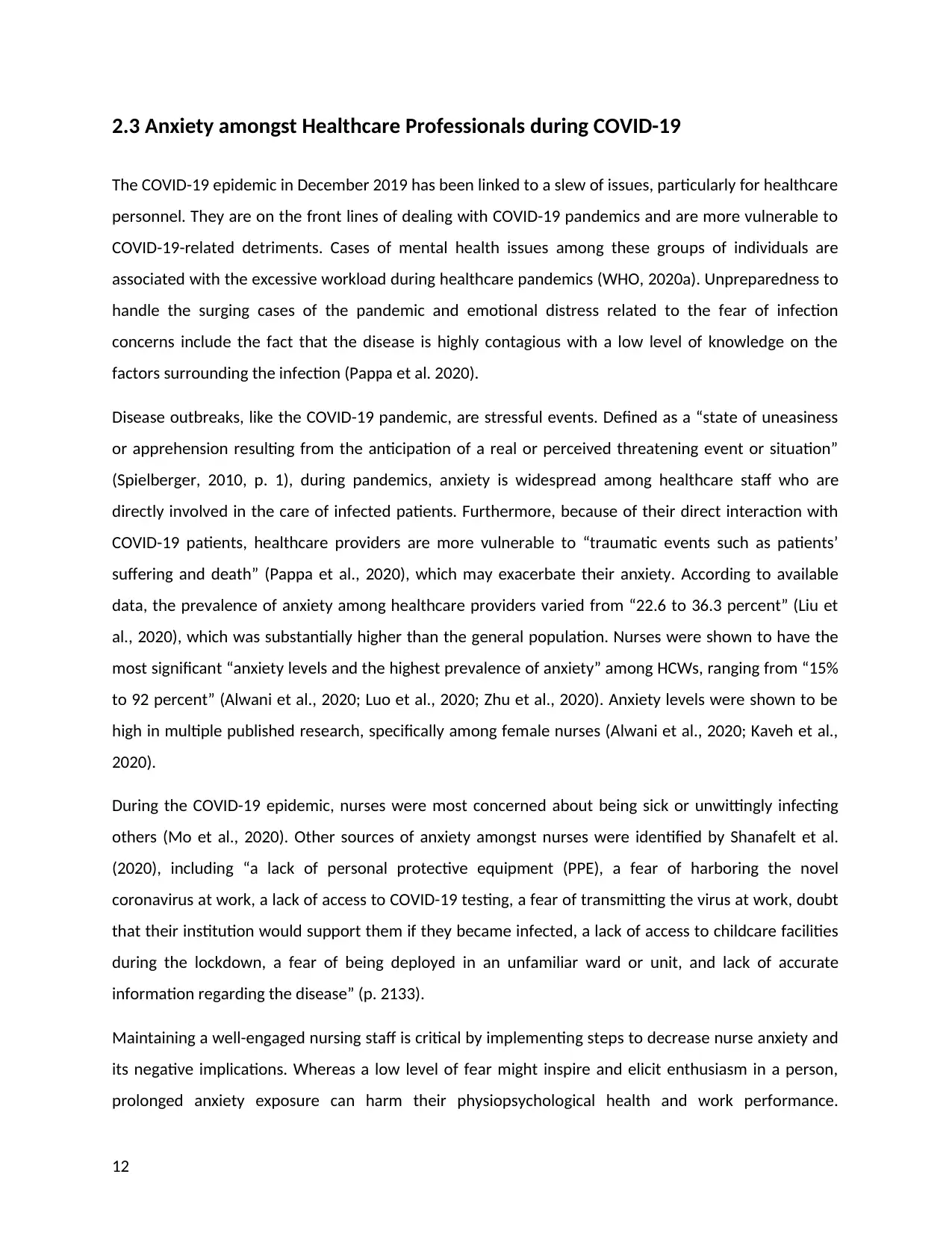
2.3 Anxiety amongst Healthcare Professionals during COVID-19
The COVID-19 epidemic in December 2019 has been linked to a slew of issues, particularly for healthcare
personnel. They are on the front lines of dealing with COVID-19 pandemics and are more vulnerable to
COVID-19-related detriments. Cases of mental health issues among these groups of individuals are
associated with the excessive workload during healthcare pandemics (WHO, 2020a). Unpreparedness to
handle the surging cases of the pandemic and emotional distress related to the fear of infection
concerns include the fact that the disease is highly contagious with a low level of knowledge on the
factors surrounding the infection (Pappa et al. 2020).
Disease outbreaks, like the COVID-19 pandemic, are stressful events. Defined as a “state of uneasiness
or apprehension resulting from the anticipation of a real or perceived threatening event or situation”
(Spielberger, 2010, p. 1), during pandemics, anxiety is widespread among healthcare staff who are
directly involved in the care of infected patients. Furthermore, because of their direct interaction with
COVID-19 patients, healthcare providers are more vulnerable to “traumatic events such as patients’
suffering and death” (Pappa et al., 2020), which may exacerbate their anxiety. According to available
data, the prevalence of anxiety among healthcare providers varied from “22.6 to 36.3 percent” (Liu et
al., 2020), which was substantially higher than the general population. Nurses were shown to have the
most significant “anxiety levels and the highest prevalence of anxiety” among HCWs, ranging from “15%
to 92 percent” (Alwani et al., 2020; Luo et al., 2020; Zhu et al., 2020). Anxiety levels were shown to be
high in multiple published research, specifically among female nurses (Alwani et al., 2020; Kaveh et al.,
2020).
During the COVID-19 epidemic, nurses were most concerned about being sick or unwittingly infecting
others (Mo et al., 2020). Other sources of anxiety amongst nurses were identified by Shanafelt et al.
(2020), including “a lack of personal protective equipment (PPE), a fear of harboring the novel
coronavirus at work, a lack of access to COVID-19 testing, a fear of transmitting the virus at work, doubt
that their institution would support them if they became infected, a lack of access to childcare facilities
during the lockdown, a fear of being deployed in an unfamiliar ward or unit, and lack of accurate
information regarding the disease” (p. 2133).
Maintaining a well-engaged nursing staff is critical by implementing steps to decrease nurse anxiety and
its negative implications. Whereas a low level of fear might inspire and elicit enthusiasm in a person,
prolonged anxiety exposure can harm their physiopsychological health and work performance.
12
The COVID-19 epidemic in December 2019 has been linked to a slew of issues, particularly for healthcare
personnel. They are on the front lines of dealing with COVID-19 pandemics and are more vulnerable to
COVID-19-related detriments. Cases of mental health issues among these groups of individuals are
associated with the excessive workload during healthcare pandemics (WHO, 2020a). Unpreparedness to
handle the surging cases of the pandemic and emotional distress related to the fear of infection
concerns include the fact that the disease is highly contagious with a low level of knowledge on the
factors surrounding the infection (Pappa et al. 2020).
Disease outbreaks, like the COVID-19 pandemic, are stressful events. Defined as a “state of uneasiness
or apprehension resulting from the anticipation of a real or perceived threatening event or situation”
(Spielberger, 2010, p. 1), during pandemics, anxiety is widespread among healthcare staff who are
directly involved in the care of infected patients. Furthermore, because of their direct interaction with
COVID-19 patients, healthcare providers are more vulnerable to “traumatic events such as patients’
suffering and death” (Pappa et al., 2020), which may exacerbate their anxiety. According to available
data, the prevalence of anxiety among healthcare providers varied from “22.6 to 36.3 percent” (Liu et
al., 2020), which was substantially higher than the general population. Nurses were shown to have the
most significant “anxiety levels and the highest prevalence of anxiety” among HCWs, ranging from “15%
to 92 percent” (Alwani et al., 2020; Luo et al., 2020; Zhu et al., 2020). Anxiety levels were shown to be
high in multiple published research, specifically among female nurses (Alwani et al., 2020; Kaveh et al.,
2020).
During the COVID-19 epidemic, nurses were most concerned about being sick or unwittingly infecting
others (Mo et al., 2020). Other sources of anxiety amongst nurses were identified by Shanafelt et al.
(2020), including “a lack of personal protective equipment (PPE), a fear of harboring the novel
coronavirus at work, a lack of access to COVID-19 testing, a fear of transmitting the virus at work, doubt
that their institution would support them if they became infected, a lack of access to childcare facilities
during the lockdown, a fear of being deployed in an unfamiliar ward or unit, and lack of accurate
information regarding the disease” (p. 2133).
Maintaining a well-engaged nursing staff is critical by implementing steps to decrease nurse anxiety and
its negative implications. Whereas a low level of fear might inspire and elicit enthusiasm in a person,
prolonged anxiety exposure can harm their physiopsychological health and work performance.
12
⊘ This is a preview!⊘
Do you want full access?
Subscribe today to unlock all pages.

Trusted by 1+ million students worldwide
1 out of 60
Related Documents
Your All-in-One AI-Powered Toolkit for Academic Success.
+13062052269
info@desklib.com
Available 24*7 on WhatsApp / Email
![[object Object]](/_next/static/media/star-bottom.7253800d.svg)
Unlock your academic potential
Copyright © 2020–2025 A2Z Services. All Rights Reserved. Developed and managed by ZUCOL.




